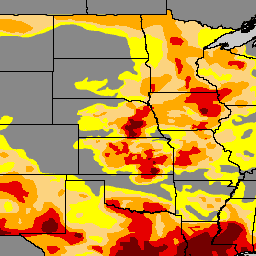
- Владелец каталога
- Потрясающий каталог сообщества GEE
- Доступность набора данных
- 2000-01-04T00:00:00Z–2025-11-18T00:00:00Z
- Поставщик наборов данных
- Национальный центр по смягчению последствий засухи
- Теги
- NDMC
Описание
Монитор засух США (US Drought Monitor) – это карта, публикуемая каждый четверг, на которой показаны районы США, охваченные засухой. Карта использует пять уровней: аномально сухой (D0), показывающий районы, которые могут начать или выйти из состояния засухи, и четыре уровня засухи: умеренный (D1), сильный (D2), экстремальный (D3) и исключительный (D4). Монитор засух – это коллективный проект с момента его создания в 1999 году, совместно разработанный Национальным центром по смягчению последствий засухи (NDMC) при Университете Небраски-Линкольна, Национальным управлением океанических и атмосферных исследований (NOAA) и Министерством сельского хозяйства США (USDA). NDMC размещает веб-сайт монитора засух и связанные с ним данные, а также предоставляет карту и данные NOAA, USDA и другим агентствам. Он доступен бесплатно по адресу drymonitor.unl.edu.
Группы
Размер пикселя
250 метров
Группы
| Имя | Мин. | Макс | Размер пикселя | Описание |
|---|---|---|---|---|
DM | 0 | 4 | метров | Классы засухи |
Условия эксплуатации
Условия эксплуатации
Работа лицензирована по лицензии Open Data для использования. U.S. Drought Monitor совместно разрабатывается Национальным центром по смягчению последствий засухи при Университете Небраски в Линкольне, Министерством сельского хозяйства США и Национальным управлением океанических и атмосферных исследований. Карта предоставлена NDMC.
Цитаты
Национальный центр по смягчению последствий засухи; Министерство сельского хозяйства США; Национальное управление океанических и атмосферных исследований (2023). Монитор засухи в США. Университет Небраски в Линкольне. https://droughtmonitor.unl.edu/. Дата обращения: 17 сентября 2023 г.
Исследуйте с Earth Engine
Редактор кода (JavaScript)
var usdm = ee.ImageCollection( "projects/sat-io/open-datasets/us-drought-monitor" ); /* Category Description DO Abnormally Dry D1 Moderate Drought D2 Severe Drought D3 Extreme Drought D4 Exceptional Drought */ var usdm = ee.Image(usdm.toList(usdm.size()).get(-1)); // Define a dictionary which will be used to make legend and visualize image on map var dict = { names: [ "DO Abnormally Dry", //1 "D1 Moderate Drought", //2 "D2 Severe Drought", //3 "D3 Extreme Drought", //4 "D4 Exceptional Drought", //5 ], colors: ["FFFF00", "FCD37F", "FFAA00", "E60000", "730000"], }; // Create a panel to hold the legend widget var legend = ui.Panel({ style: { position: "bottom-left", padding: "8px 15px", }, }); // Function to generate the legend function addCategoricalLegend(panel, dict, title) { // Create and add the legend title. var legendTitle = ui.Label({ value: title, style: { fontWeight: "bold", fontSize: "18px", margin: "0 0 4px 0", padding: "0", }, }); panel.add(legendTitle); var loading = ui.Label("Loading legend...", { margin: "2px 0 4px 0" }); panel.add(loading); // Creates and styles 1 row of the legend. var makeRow = function (color, name) { // Create the label that is actually the colored box. var colorBox = ui.Label({ style: { backgroundColor: color, // Use padding to give the box height and width. padding: "8px", margin: "0 0 4px 0", }, }); // Create the label filled with the description text. var description = ui.Label({ value: name, style: { margin: "0 0 4px 6px" }, }); return ui.Panel({ widgets: [colorBox, description], layout: ui.Panel.Layout.Flow("horizontal"), }); }; // Get the list of palette colors and class names from the image. var palette = dict["colors"]; var names = dict["names"]; loading.style().set("shown", false); for (var i = 0; i < names.length; i++) { panel.add(makeRow(palette[i], names[i])); } Map.add(panel); } /* // Display map and legend /////////////////////////////////////////////////////////////////////////////// */ // Add the legend to the map addCategoricalLegend(legend, dict, "US Drought Monitor"); // Add USDM Image image to the map Map.addLayer( usdm, { min: 0, max: 4, palette: dict["colors"] }, usdm.get("system:index").getInfo() );

